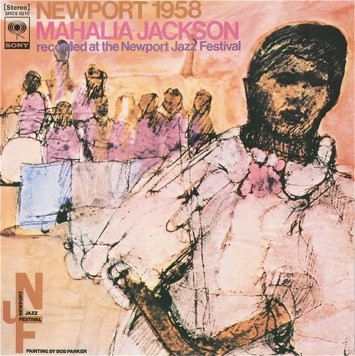
Timeline of the Golden Age of Gospel (1940s)
For more clarity the following factors and the timeline that follows give an overview of the rapid and successful development of the golden age of gospel beginning in the 1940s:
- Many solo artists were becoming popular through their recordings.
- Gospel music found its place in secular as well as sacred environments.
- Male quartet and quintet vocal groups were becoming popular.
- More so than before, the instrumental accompaniment contributed to the performance in a more significant way, including borrowing accompaniment characteristics in secular styles of the day, namely blues, rhythm and blues, and soul.
| Year | Artists | Event | Legacy/Significance |
|---|---|---|---|
| 1930-1964 | Various artists | The Chicagoland Music Festival | 1) Formed by the Chicago Daily Tribune, this festival, held at Soldier Field, included various styles of music such as religious and patriotic that eventually helped to improve race relations between Blacks and Whites; 2) By the 1940s 100,000 people came together; 3) J. Wesley Jones's chorus of over 1,000-voices of Black singers was often the featured attraction. To mitigate negative racial tensions in the city, an even larger chorus of White singers joined Black singers to perform the "Hallelujah "chorus in Handel's Messiah. |
| 1939-1949 | Various artists | American Negro Music Festival | 1) A music festival in Chicago, first at Soldier Field then to Comiskey Park, and finally in 1949 to Chicago Coliseum, that featured religious music (mainly spirituals and Gospel), but African American styles such as classical (performed by Roland Hayes and Paul Robeson), blues, and boogie-woogie (performed by (Dorothy Donegan and Lionel Hampton's Band) were also performed; 2) Like the Chicagoland Music Festival, the American Negro Music Festival was proud to boast its endeavour to improve interracial relations in Chicago. |
| 1940-1980s | Sallie Martin (1895-1988) & Kenneth Morris (1917-1988) | Publisher of gospel music from 1940-1980s; it thrived during the golden age of gospel music | 1) An African American owned publishing company; 2) Martin & Morris Music Studio was the largest and most successful publisher of gospel music in America; 3) Published compositions, in addition to their own works, including those from noted composers such as Thomas A. Dorsey, William Hebert Brewster, Alex Bradford, Lucie Campbell, Dorothy Love Coates, Sam Cook, and others; 4) This business was a major source of gospel material for former and newly emerging soloists and small groups, as well as for choir directors. |
| 1940s-50s | Swan Silvertones | Male quartet singing style | 1) Perhaps the most popular among the barbershop-style of singing, which later became widely known as doo-wop; 2) This style of singing featured a lead singer (often tenor), two to three background singers (tenor and baritones), and a bass singer. |
| 1940s-50s | Soul Stirrers | Male quartet singing style |
1) This group also popularized the barbershop-style of singing, that later became widely known as doo-wop; 2) This style of singing featured a lead singer (often tenor), two to three background singers (tenor and baritones), and a bass singer 
Sam Cooke and the soul Stirrers |
| 1944 | Kenneth Morris | Performance of "Just A Closer Walk With Thee" to the National Baptist Convention | 1) This song, though the author is unknown, is a popular melody that was sung among slaves as early as the 1800s; 2) Its melodic, harmonic, and rhythmic characteristics were duly accepted in sacred and secular music context, Gospel and jazz respectively; 3) The popularity of this song, perhaps more than any other at this time, opened the flood gate of greater interest in gospel music in general |
| Mid. 1940s | Embassy Auditorium of Los Angeles | In Los Angeles, this venue became one of the most popular places for gospel festivals | |
| 1947 | Echoes of Eden Choir, which was formed by combining three choirs | Radio Broadcast | 1) Echoes of Eden broadcast, which reached about one million people in seventeen states, featured the Echoes of Eden Choir of the St. Paul Baptist Church of Los Angeles; 2) Through radio, gospel music was reaching people in secular as well as sacred contexts; 3) They recorded two albums for Capitol Records. |
| 1947 | Mahalia Jackson (1911-1972) | Recorded "Move On Up A Little Higher", which ignited interest in gospel music |
1) This recording (Apollo label) helped to ignite great interest in gospel music; 2) Gospel music was being disseminated in a non-sacred context (i.e., not only in church); 3.) International recognition of gospel music during the 1950s can be greatly attributed to Mahalia Jackson. 
Move On Up A Little Higher Record |
| 1949-50 | Voice of Victory(founded 1943) |
1) According to the church history, their popularity and congregation grew exponentially when their Sunday Night serice was aired on KTTV, Channel 11. During the height of the Civil Rights Movement, it had a number of fundraisers in support of the movement, and it is noted Dr. Martin Luther King, Jr. was a guest speaker at Victory Baptist church in Los Angeles on June 25, 1967. 
Voice of Victory Church |
|
| 1950 | Mahalia Jackson | Performance at Carnegie Hall, NYC | 1) First major gospel artist to perform at Carnegie Hall; 2) Carnegie Hall represents artists and music that achieve high standards, thus Mahalia Jackson and gospel music are viewed as such; 3) Gospel music was being disseminated in a non-sacred context (i.e., not only in church) |
| 1950 | Performance on KTLA TV |
Performance by the Echoes of Eden Choir under the direction of Sallie Martin, which resulted in her being the first religious host on national TV. 
KTLA Logo |
|
| 1951 | Clara Ward (1924-1973) | Composed and recorded "How I Got Over," which was later recorded by other noted artists such as Mahalia Jackson |
1) The song was composed and first recorded by Clara Ward in 1951; 2) This recording helped to solidify gospel music presence; 3) This recording shows that gospel music was being disseminated in a non-sacred context (i.e., not only in church) 
Clara Ward |
| July 3, 1953 | Various Performers | Gospelcade at the Embassy Auditorium in Los Angeles | 1) Marketed as the first gospel music festival in Los Angeles. 2) Despite the church as the main place for gospel performances, concerts, and festivals, this event showed that gospel music was being heard in secular venues as well. 
Embassy Auditorium |
| 1954 | Alex Bradford (1827-1978) | Composed and recorded "Too Close To Heaven" |
1) This was Bradford's first hit, which sold more than a million copies; 2) His charismatic stage presence and flamboyancy influence artists such as Little Richard and Ray Charles; 3) This recording shows that gospel music was being disseminated in a non-sacred context (i.e., not only in church) 
Alex Bradford Too Close to Heaven Record |
| 1950s-60s | The Caravans | Noted early members who became popular as soloists include Shirley Caesar, Albertina Walker, Bessie Griffin, and Dorothy Norwood |
1) In addition to its stellar performances of gospel music as a group, it boasted as a group with many soloists 
The Caravans |
| 1957 | Clara Ward & The Ward Singers | Performance at the Newport Jazz Festival, NY. |
1) First gospel artist to perform at the Newport Jazz Festival, Rhode Island; 2) Gospel music was being disseminated in a non-sacred context (i.e., not only in church); 2) They favored sequenced gowns and other flamboyant attire instead of the typical choir robes sported by their contemporaries 
Clara Ward & The Ward Singers |
| 1958 | Mahalia Jackson | Performance at the Newport Jazz Festival, NY. |
1) Though not the first gospel artist to perform at this festival, this major artist's appearance the following year since the first occurrence shows its relevance to performing in a non-sacred context (i.e., not only in church) 
Mahalia Jackson Newport 1958 |
| 1961 | Langston Hughes | Black Nativity | 1) A gospel play that tells the Christmas story with an all-Black cast. 2) It features gospel songs and spirituals, as well as encourages audience participation in singing in a call & response manner, typical for Black congregations. 
Black Nativity |
| 1961 | Doris Akers | Gospel Composer of the Year | 1) Doris Akers became a millionaire due to publications of her compositions and her popularity as a performer. 2) She directed the all-white Sky Pilot Choir, which many believed had a "Black sound." 
Doris Akers |
| 1962 | Langston Hughes | The Gospel Glory | 1) A gospel play that tells the Christ story from a Black perspective. 2) It features traditional Christmas songs such as “Away in a Manger” and “O Holy Night”, blues music like “Dry Bones”, and, of course, composed gospel music for the play. 
Langston Hughes |
| 1963 | Langston Hughes | Tambourines to Glory | 1) This gospel play is Hughes’s misgivings of the Black store-front church. In short, a play of good vs. Evil. 2) It features gospel and blues music, as well as encourages audience participation in singing in a call & response manner, typical for Black congregations. 
Tambourines to Glory |
| 1963 | Bessie Griffin | Performed on the Ed Sullivan Show |
1) Considered the most popular variety show at the time; 2) Gospel music was being disseminated in a non-sacred context (i.e., not only in church) by a major artist 
Bessie Griffin |
| 1963 | Mahalia Jackson | Performance on the steps of the Lincoln Memorial |
1) This performance marks the time of the March on Washington, DC, when Dr. King gave his landmark I have A Dream speech; 2) Gospel music was being disseminated in a non-sacred context (i.e., not only in church) by a major artist 
Mahalia Jackson Performs |
Precious Lord
Through the storm, through the night
Lead me on to the light
Take my hand precious Lord, lead me home
It's a Highway to Heaven
It's a highway to heaven
None can walk up there
But the pure in heart
It's a highway to heaven
Walking up the king's highway





